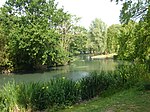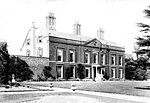Edmonton air crash
1938 disasters in the United Kingdom1938 in London20th century in MiddlesexAccidents and incidents involving Royal Air Force aircraftAviation accidents and incidents in 1938 ... and 5 more
Aviation accidents and incidents in LondonDisasters in MiddlesexEdmonton, LondonHistory of the London Borough of EnfieldUse British English from December 2016

The Edmonton air crash occurred on 4 September 1938. A Hawker Audax (serial number K7381) of No. 1 Elementary and Reserve Flying Training School, Royal Air Force, based at Hatfield, crashed into a residential area in Edmonton, Middlesex (now Greater London). The aircraft was being flown by a 19-year-old pilot, Sgt Stanley Robert Morris RAFVR. The pilot and 12 people on the ground were killed, including four children.
Excerpt from the Wikipedia article Edmonton air crash (License: CC BY-SA 3.0, Authors, Images).Edmonton air crash
Chalfont Road, London Edmonton (London Borough of Enfield)
Geographical coordinates (GPS) Address Nearby Places Show on map
Geographical coordinates (GPS)
| Latitude | Longitude |
|---|---|
| N 51.622233333333 ° | E -0.068922222222222 ° |
Address
Chalfont Road
Chalfont Road
N9 9LW London, Edmonton (London Borough of Enfield)
England, United Kingdom
Open on Google Maps








